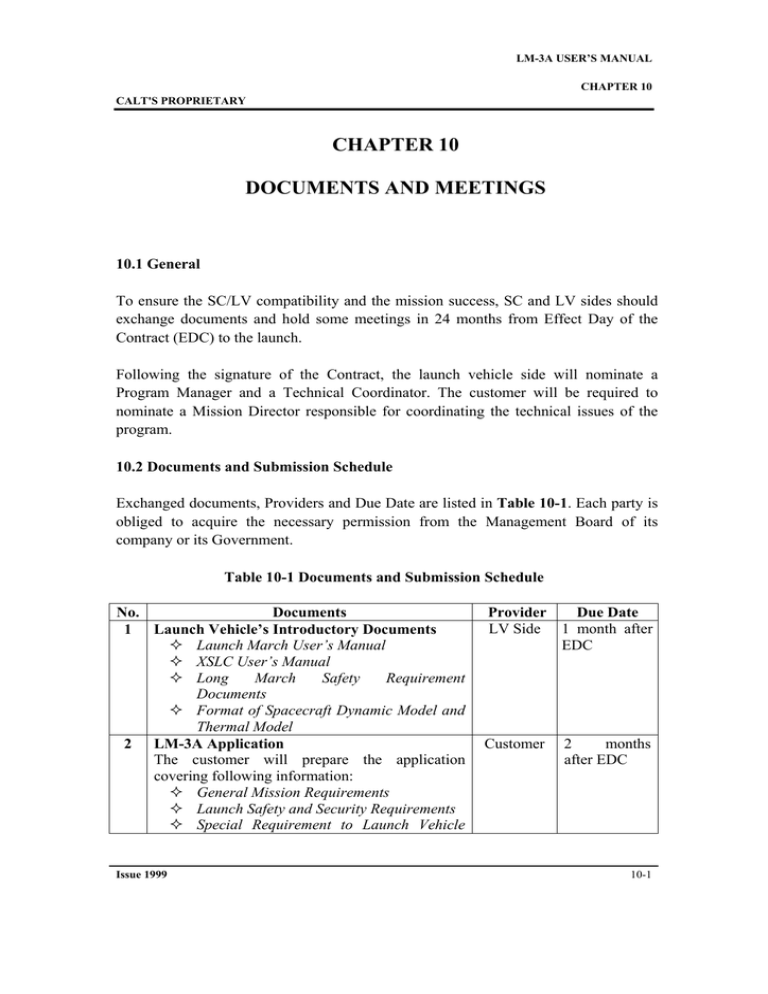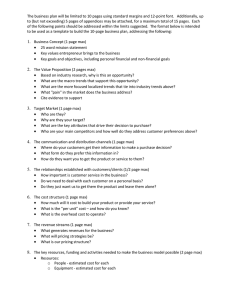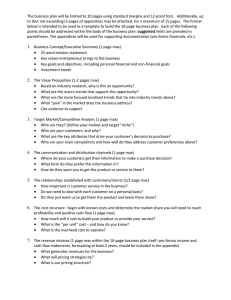CHAPTER 10 DOCUMENTS AND MEETINGS
advertisement

LM-3A USER’S MANUAL CHAPTER 10 CALT'S PROPRIETARY CHAPTER 10 DOCUMENTS AND MEETINGS 10.1 General To ensure the SC/LV compatibility and the mission success, SC and LV sides should exchange documents and hold some meetings in 24 months from Effect Day of the Contract (EDC) to the launch. Following the signature of the Contract, the launch vehicle side will nominate a Program Manager and a Technical Coordinator. The customer will be required to nominate a Mission Director responsible for coordinating the technical issues of the program. 10.2 Documents and Submission Schedule Exchanged documents, Providers and Due Date are listed in Table 10-1. Each party is obliged to acquire the necessary permission from the Management Board of its company or its Government. Table 10-1 Documents and Submission Schedule No. Documents 1 Launch Vehicle’s Introductory Documents Launch March User’s Manual XSLC User’s Manual Long March Safety Requirement Documents Format of Spacecraft Dynamic Model and Thermal Model 2 LM-3A Application The customer will prepare the application covering following information: General Mission Requirements Launch Safety and Security Requirements Special Requirement to Launch Vehicle Issue 1999 Provider Due Date LV Side 1 month after EDC Customer 2 months after EDC 10-1 LM-3A USER’S MANUAL CHAPTER 10 CALT'S PROPRIETARY No. 3 4 5 6 7 Documents and Launch Center The application is used for very beginning of the program. Some technical data could be defined during implementation of the contract. Spacecraft Dynamic Math Model (Preliminary and Final) The customer shall provide hard copies and floppy diskettes according to Format of Spacecraft Dynamic Model and Thermal Model. CALT will perform dynamic Coupled Load Analysis with the model. The customer shall specify the output requirement in the printing. The math model would be submitted once or twice according to progress of the program. Dynamic Coupled Load Analysis (Preliminary and Final) CALT will integrate SC model, launch vehicle model and flight characteristics together to calculate loads on SC/LV interface at some critical moments. The customer may get the dynamic parameters inside spacecraft using analysis result. Analysis would be carried out once or twice depending on the progress of the program. Spacecraft Thermal Model The customer shall provide printed documents and floppy diskettes of spacecraft thermal model according to Format of Spacecraft Dynamic Model and Thermal Model. CALT will use the model for thermal environment analysis. The analysis output requirement should be specified in printing. Thermal Analysis This analysis determines the spacecraft thermal environment from the arrival of the spacecraft to its separation from the launch vehicle. Spacecraft Interface Requirement and Spacecraft Configuration Drawings (preliminary and final) Launch Orbit, mass properties, launch constrains and separation conditions. Issue 1999 Provider Due Date Customer 2 month after No.1 CALT 3 months after No.3. Customer 2 month after No.1 CALT 3 months after No.5 Customer 3 months after EDC. 10-2 LM-3A USER’S MANUAL CHAPTER 10 CALT'S PROPRIETARY No. 8 9 10 Documents Detailed spacecraft mechanical interfaces, electrical interfaces and RF characteristics Combined operation requirement and constrains. 3 months after EDC, customer should provide the spacecraft configuration drawings to the launch vehicle side. For minimal or potential extrusion out of fairing envelope, it is encouraged to settle the issue with CALT one year before launch. Mission Analyses (Preliminary and Final) LV side should provide the customer with preliminary and final mission analysis report according to customer’s requirements. Both sides shall jointly review these reports for SC/LV compatibility. Trajectory Analysis To optimize the launch mission by determining launch sequence, flight trajectory and performance margin. Flight Mechanics Analyses To determine the separation energy and post-separation kinematics conditions (including separation analysis and collision avoidance analysis). Interface Compatibility Analyses To review the SC/LV compatibility (mechanical interface, electrical interface and RF link/working plan). Spacecraft Environmental Test Document The document should detail the test items, test results and some related analysis conclusions. The survivability and the margins of the spacecraft should also be included. The document will be jointly reviewed. Safety Control Documents To ensure the safety of the spacecraft, launch vehicle and launch site, the customer shall submit documents describing all hazardous systems and operations, together with corresponding safety analysis, according to Long March Safety Requirement Documents. Both sides will jointly review this document. Issue 1999 Provider Due Date CALT 3 month after No.7 Customer 15 days after the test Customer 2 months after EDC to 6 months before launch 10-3 LM-3A USER’S MANUAL CHAPTER 10 CALT'S PROPRIETARY No. Documents 11 Spacecraft Operation Plan This Plan shall describe the spacecraft operations in the launch site, the launch team composition and responsibilities. The requirements to the facilities in launch site should also be detailed. Both sides will jointly review this document. Part of the document will be incorporated into ICD and most part will be written into SC/LV Combined Operation Procedure. 12 SC/LV Combined Operations Procedure The document contains all jointly participated activities following the spacecraft arrival, such as facility preparations, pre-launch tests, SC/LV integration and real launch. The launch vehicle side will work out the Combined Operation Procedure based on Spacecraft Operation Plan. Both sides will jointly review this procedure. 13 14 15 Provider Both Sides Both Sides 4 month before launch Customer Final Mass Property Report The spacecraft's mass property is finally measured and calculated after all tests and operations are completed. The data should be provided one day before SC/LV integration Both Sides Go/No go Criteria This document specifies the GO/NO-GO orders issued by the relevant commanders of the mission team. The operation steps have been specified inside SC/LV Combined Operation Procedure. LV Side Injection Data Report The initial injection data of the spacecraft will be provided 40 minutes after SC/LV separation. This document will either be handed to the customer's representative at XSLC or sent via telex or facsimile to a destination selected by the customer. Both sides will sign on this document. Issue 1999 Due Date 8 months before launch 1 day before mating of SC/LV 15 days before launch 40 minutes after orbit injection 10-4 LM-3A USER’S MANUAL CHAPTER 10 CALT'S PROPRIETARY No. Documents 16 Orbital Tracking Report The customer is required to provide spacecraft orbital data obtained prior to any spacecraft maneuver. This data is used to re-check the launch vehicle performance. 17 Launch Mission Evaluation Report Using the data obtained from launch vehicle telemetry, the launch vehicle side will provide assessment to the launch vehicle's performance. This will include a comparison of flight data with preflight predictions. The report will be submitted 45 days after a successful launch or 15 days after a failure. Provider Customer Due Date 20 days after launch CALT 45 day after launch 10.3 Reviews and Meetings During the implementation of the contract, some reviews and technical coordination meetings will be held. The specific time and locations are dependent on the program process. Generally the meetings are held in spacecraft side or launch vehicle side alternatively. The topics of the meetings are listed in Table 10-2, which could be adjusted and repeated, as agreed upon by the parties. No. 1 Table 10-2 Reviews and Meetings Meetings Kick-off Meeting In this meeting, both parties will introduce the management and plan of the program. The major characteristics, interface configuration and separation design are also described. The design discussed in that meeting is not final, which will be perfected during the follow-up coordination. Kick-off Meeting will cover, but not be limited to, the following issues: Program management, interfaces and schedule Spacecraft program, launch requirements and interface requirements Launch vehicle performance and existing interfaces Outlines of ICD for this program Launch site operations and safety Issue 1999 10-5 LM-3A USER’S MANUAL CHAPTER 10 CALT'S PROPRIETARY No. 2 3 4 5 6 7 8 Meetings Interface Control Document Review (ICDR) The purpose of the ICD Review is to ensure that all the interfaces meet the spacecraft’s requirements. The ICD will be reviewed twice, preliminary and final. Some intermediate reviews will be held if necessary. Action Items will be generated in the reviews to finalize the ICD for the specific program. Mission Analyses Reviews (MAR) The preliminary MAR follows the preliminary mission analyses to draft ICD and work out the requirements for spacecraft environment test. The final MAR will review the final mission analyses and spacecraft environment test result and finalize the mission parameters. ICD will be updated according to the output of that meeting. Spacecraft Safety Reviews Generally, there are three safety reviews after the three submissions of Safety Control Documents. The submittals and questions/answers will be reviewed in the meeting. XSLC Facility Acceptance Review This review is held at XSLC six months before launch. The spacecraft project team will be invited to this review. The purpose of this review is to verify that the launch site facilities satisfy the Launch Requirements Documents. Combined Operation Procedure Review This review will be held at XSLC following the submission of Combined Operation Procedures, drafted by the customer. The Combined Operation Procedure will be finalized by incorporating the comments put forward in the review. Launch Vehicle Pre-shipment Review (PSR) This review is held in CALT facility four months before launch. The purpose of that meeting is to confirm that the launch vehicle meet the specific requirements in the process of design manufacture and testing. The delivery date to XSLC will be discussed in that meeting. CALT has a detailed report to the customer introducing the technical configuration and quality assurance of the launch vehicle. The review is focused on various interfaces Flight Readiness Review (FRR) This review is held at XSLC after the launch rehearsal. The review will cover the status of spacecraft, launch vehicle, launch facilities and TT&C network. The launch campaign will enter the fueling preparation after this review. Issue 1999 10-6 LM-3A USER’S MANUAL CHAPTER 10 CALT'S PROPRIETARY No. 9 Meetings Launch Site Operation Meetings The daily meeting will be held in the launch site at the mutually agreed time. The routine topics are reporting the status of spacecraft, launch vehicle and launch site, applying supports from launch site and coordinating the activities of all sides. The weekly planning meeting will be arranged if necessary. Issue 1999 10-7 LM-3A USER’S MANUAL CALT'S PROPRIETARY CHAPTER 10 -24 -23 -22 -21 -20 -19 -18 -17 -16 -15 -14 -13 -12 -11 -10 -9 -8 -8 -7 -7 -6 -6 -5 -5 -4 -4 -3 -3 -2 -2 -1 -1 0 0 +1 +2 +1 +2 MONTHS -24 -23 -22 -21 -20 -19 -18 -17 -16 -15 -14 -13 -12 -11 -10 -9 MONTHS Figure 10-1 Time-schedule of Documentation and Reviews 10-8 10-8 Issue 1999






